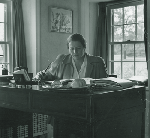

Pearl S. Buck’s novel, Peony, depicts the story of the Jewish family Ezra, in China, who is struggling against Chinese ideals. Though the novel mainly portrays the ideology of the Jewish religion, Buck is able to intertwine her knowledge of Confucianism into this struggle. Buck does this by the use of characters, irony, and theme.
The theme of Peony
is the deterioration of Judaism in China. Pearl Buck uses a counter
religion/philosophy to help express this deterioration. Confucianism
is incorporated to show the different beliefs and traditions that Jews
faced because of being a minority in the Far East. Buck’s use of
character identity and interaction also represents her knowledge of Confucianism
and the conflict between that and Judaism. Wang Ma, the bondmaid
for Ezra, is a strict believer in Confucianism. On the other hand,
Madame Ezra is a devout Jewish woman. Irony also plays an important
role in Buck’s novel Peony. In the book, irony is used to emphasize
that Judaism cannot escape the influence of Confucianism. The most
pertinent example of this is when David goes to the Jewish temple to read
the hallowed tablets. The tablet containss the most potent
influence of Confucian thought. It is ironic that in the Holy Scriptures
of the Jewish religion appears the epitome of Confucian beliefs.
Another ironic aspect of the novel Peony is that despite all of Madame
Ezra’s extreme measures to ensure that David will marry a Jewish girl,
he marries into a Chinese family. Her attempts to carry on the Jewish
traditions through her son are futile. It is situational irony that
Madame Ezra was trying so hard to protect her family and keep Confucianism
out, and yet in the end the exact opposite occurs (all of her descendents
will be Chinese with the Confucian religion).
Pearl S. Buck’s Peony is
a novel of conflict between the ideology of the Jewish religion and that
of Confucianism. In the novel her knowledge of Confucianism leads to the
conclusion that it is the stronger of the two religions.